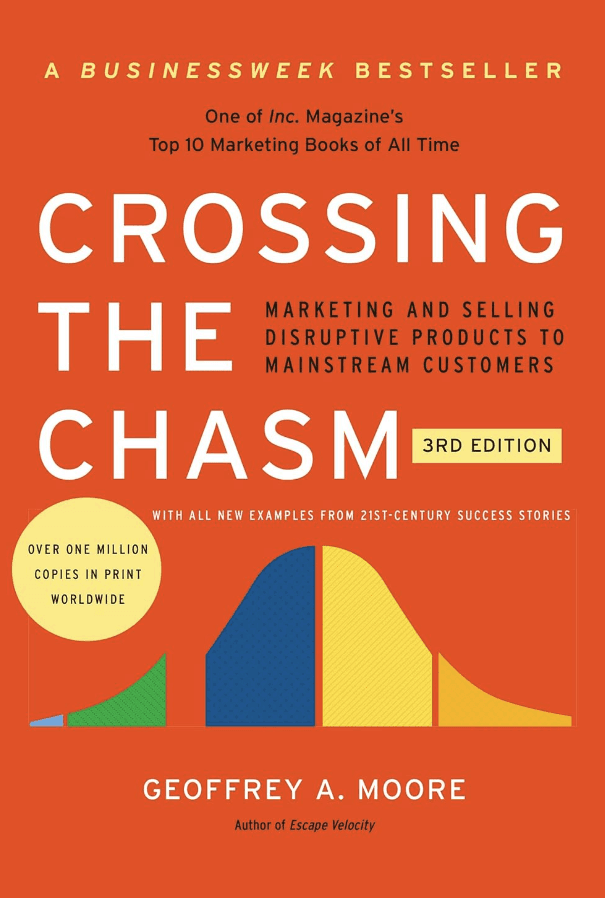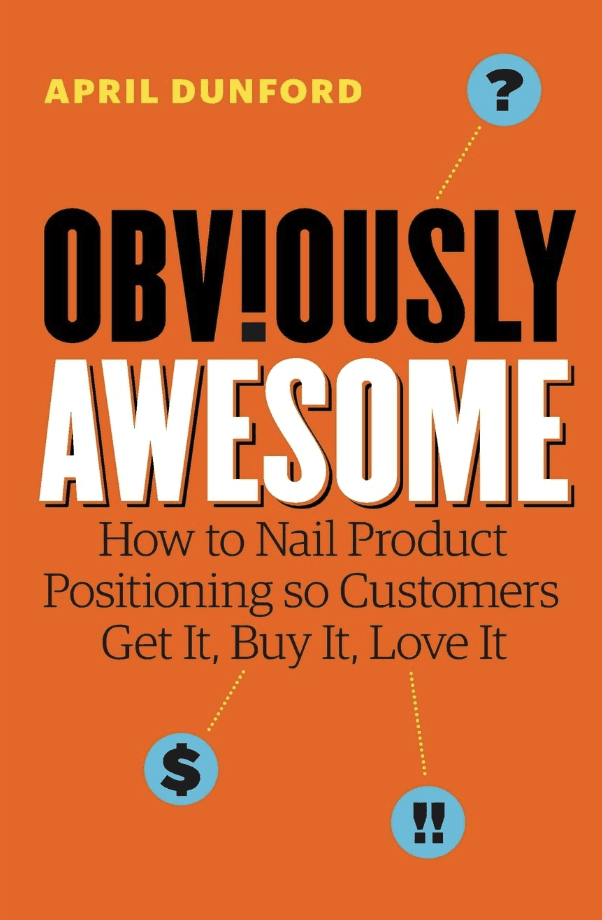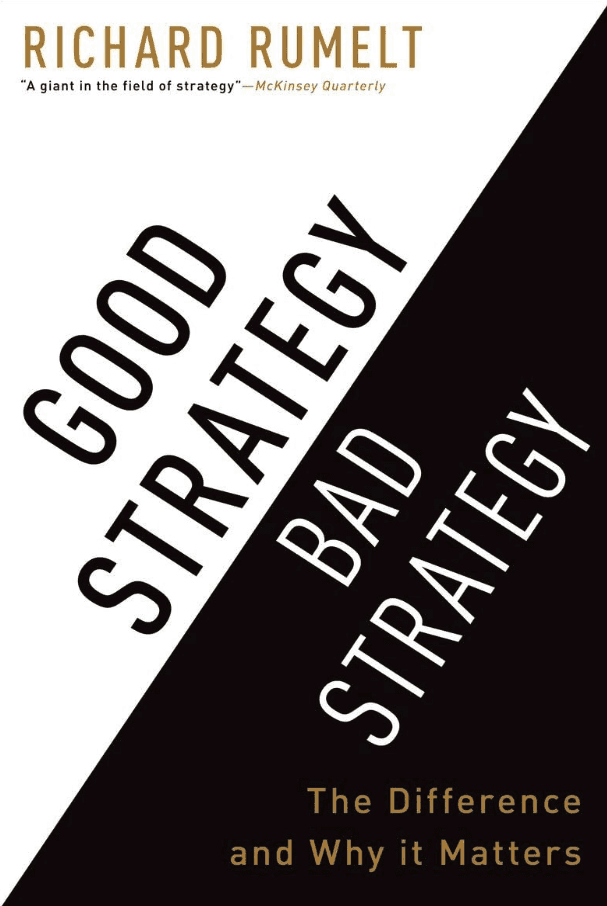Crossing the ChasmMarketing and Selling Disruptive Products to Mainstream Customers.
The bible for bringing cutting-edge products to larger markets—now revised and updated with new insights into the realities of high-tech marketing
In Crossing the Chasm, Geoffrey A. Moore shows that in the Technology Adoption Life Cycle—which begins with innovators and moves to early adopters, early majority, late majority, and laggards—there is a vast chasm between the early adopters and the early majority. While early adopters are willing to sacrifice for the advantage of being first, the early majority waits until they know that the technology actually offers improvements in productivity. The challenge for innovators and marketers is to narrow this chasm and ultimately accelerate adoption across every segment.
This third edition brings Moore's classic work up to date with dozens of new examples of successes and failures, new strategies for marketing in the digital world, and Moore's most current insights and findings. He also includes two new appendices, the first connecting the ideas in Crossing the Chasm to work subsequently published in his Inside the Tornado, and the second presenting his recent groundbreaking work for technology adoption models for high-tech consumer markets.

by Geoffrey A. Moore (Author)
Obviously AwesomeHow to Nail Product Positioning so Customers Get It, Buy It, Love It.
You know your product is awesome—but does anybody else? Forget everything you thought you knew about positioning. Successfully connecting your product with consumers isn’t a matter of following trends, comparing yourself to the competition or trying to attract the widest customer base.
So what is it? April Dunford, positioning guru and tech exec, will enlighten you.
Her new book, Obviously Awesome, shows you how to find your product’s “secret sauce”—and then sell that sauce to those who crave it. Having spent years as a startup executive (with 16 product launches under her belt) and a consultant (who’s worked on dozens more), Dunford speaks with authority about breaking through the noise of a crowded market.
Punctuated with witty anecdotes and compelling case studies, Dunford’s book is at once entertaining and illuminating. Among the invaluable lessons you’ll learn are:
- The Five Components of Effective Positioning
- How to instantly connect an audience to your offering’s value
- How to choose the best market for your products
- How to use three distinct styles of positioning to your advantage
- How to leverage market trends to help buyers understand why making a purchase is important right now
Whether you’re an entrepreneur, marketer or salesperson struggling to bring inventive products to market, Dunford’s insights will help you find your awesome, so that your customers can too.

by April Dunford (Author)
Good Strategy Bad StrategyThe Difference and Why It Matters.
Good Strategy/Bad Strategy clarifies the muddled thinking underlying too many strategies and provides a clear way to create and implement a powerful action-oriented strategy for the real world.
Developing and implementing a strategy is the central task of a leader. A good strategy is a specific and coherent response to—and approach for—overcoming the obstacles to progress. A good strategy works by harnessing and applying power where it will have the greatest effect. Yet, Rumelt shows that there has been a growing and unfortunate tendency to equate Mom-and-apple-pie values, fluffy packages of buzzwords, motivational slogans, and financial goals with “strategy.”
In Good Strategy/Bad Strategy, he debunks these elements of “bad strategy” and awakens an understanding of the power of a “good strategy.” He introduces nine sources of power—ranging from using leverage to effectively focusing on growth—that are eye-opening yet pragmatic tools that can easily be put to work on Monday morning, and uses fascinating examples from business, nonprofit, and military affairs to bring its original and pragmatic ideas to life. The detailed examples range from Apple to General Motors, from the two Iraq wars to Afghanistan, from a small local market to Wal-Mart, from Nvidia to Silicon Graphics, from the Getty Trust to the Los Angeles Unified School District, from Cisco Systems to Paccar, and from Global Crossing to the 2007–08 financial crisis.
Reflecting an astonishing grasp and integration of economics, finance, technology, history, and the brilliance and foibles of the human character, Good Strategy/Bad Strategy stems from Rumelt’s decades of digging beyond the superficial to address hard questions with honesty and integrity.

by Richard Rumelt (Author)
Crossing the ChasmMarketing and Selling Disruptive Products to Mainstream Customers.
The bible for bringing cutting-edge products to larger markets—now revised and updated with new insights into the realities of high-tech marketing
In Crossing the Chasm, Geoffrey A. Moore shows that in the Technology Adoption Life Cycle—which begins with innovators and moves to early adopters, early majority, late majority, and laggards—there is a vast chasm between the early adopters and the early majority. While early adopters are willing to sacrifice for the advantage of being first, the early majority waits until they know that the technology actually offers improvements in productivity. The challenge for innovators and marketers is to narrow this chasm and ultimately accelerate adoption across every segment.
This third edition brings Moore's classic work up to date with dozens of new examples of successes and failures, new strategies for marketing in the digital world, and Moore's most current insights and findings. He also includes two new appendices, the first connecting the ideas in Crossing the Chasm to work subsequently published in his Inside the Tornado, and the second presenting his recent groundbreaking work for technology adoption models for high-tech consumer markets.

by Geoffrey A. Moore (Author)
Obviously AwesomeHow to Nail Product Positioning so Customers Get It, Buy It, Love It.
You know your product is awesome—but does anybody else? Forget everything you thought you knew about positioning. Successfully connecting your product with consumers isn’t a matter of following trends, comparing yourself to the competition or trying to attract the widest customer base.
So what is it? April Dunford, positioning guru and tech exec, will enlighten you.
Her new book, Obviously Awesome, shows you how to find your product’s “secret sauce”—and then sell that sauce to those who crave it. Having spent years as a startup executive (with 16 product launches under her belt) and a consultant (who’s worked on dozens more), Dunford speaks with authority about breaking through the noise of a crowded market.
Punctuated with witty anecdotes and compelling case studies, Dunford’s book is at once entertaining and illuminating. Among the invaluable lessons you’ll learn are:
- The Five Components of Effective Positioning
- How to instantly connect an audience to your offering’s value
- How to choose the best market for your products
- How to use three distinct styles of positioning to your advantage
- How to leverage market trends to help buyers understand why making a purchase is important right now
Whether you’re an entrepreneur, marketer or salesperson struggling to bring inventive products to market, Dunford’s insights will help you find your awesome, so that your customers can too.

by April Dunford (Author)
Good Strategy Bad StrategyThe Difference and Why It Matters.
Good Strategy/Bad Strategy clarifies the muddled thinking underlying too many strategies and provides a clear way to create and implement a powerful action-oriented strategy for the real world.
Developing and implementing a strategy is the central task of a leader. A good strategy is a specific and coherent response to—and approach for—overcoming the obstacles to progress. A good strategy works by harnessing and applying power where it will have the greatest effect. Yet, Rumelt shows that there has been a growing and unfortunate tendency to equate Mom-and-apple-pie values, fluffy packages of buzzwords, motivational slogans, and financial goals with “strategy.”
In Good Strategy/Bad Strategy, he debunks these elements of “bad strategy” and awakens an understanding of the power of a “good strategy.” He introduces nine sources of power—ranging from using leverage to effectively focusing on growth—that are eye-opening yet pragmatic tools that can easily be put to work on Monday morning, and uses fascinating examples from business, nonprofit, and military affairs to bring its original and pragmatic ideas to life. The detailed examples range from Apple to General Motors, from the two Iraq wars to Afghanistan, from a small local market to Wal-Mart, from Nvidia to Silicon Graphics, from the Getty Trust to the Los Angeles Unified School District, from Cisco Systems to Paccar, and from Global Crossing to the 2007–08 financial crisis.
Reflecting an astonishing grasp and integration of economics, finance, technology, history, and the brilliance and foibles of the human character, Good Strategy/Bad Strategy stems from Rumelt’s decades of digging beyond the superficial to address hard questions with honesty and integrity.

by Richard Rumelt (Author)
Crossing the ChasmMarketing and Selling Disruptive Products to Mainstream Customers.
The bible for bringing cutting-edge products to larger markets—now revised and updated with new insights into the realities of high-tech marketing
In Crossing the Chasm, Geoffrey A. Moore shows that in the Technology Adoption Life Cycle—which begins with innovators and moves to early adopters, early majority, late majority, and laggards—there is a vast chasm between the early adopters and the early majority. While early adopters are willing to sacrifice for the advantage of being first, the early majority waits until they know that the technology actually offers improvements in productivity. The challenge for innovators and marketers is to narrow this chasm and ultimately accelerate adoption across every segment.
This third edition brings Moore's classic work up to date with dozens of new examples of successes and failures, new strategies for marketing in the digital world, and Moore's most current insights and findings. He also includes two new appendices, the first connecting the ideas in Crossing the Chasm to work subsequently published in his Inside the Tornado, and the second presenting his recent groundbreaking work for technology adoption models for high-tech consumer markets.

by Geoffrey A. Moore (Author)
Obviously AwesomeHow to Nail Product Positioning so Customers Get It, Buy It, Love It.
You know your product is awesome—but does anybody else? Forget everything you thought you knew about positioning. Successfully connecting your product with consumers isn’t a matter of following trends, comparing yourself to the competition or trying to attract the widest customer base.
So what is it? April Dunford, positioning guru and tech exec, will enlighten you.
Her new book, Obviously Awesome, shows you how to find your product’s “secret sauce”—and then sell that sauce to those who crave it. Having spent years as a startup executive (with 16 product launches under her belt) and a consultant (who’s worked on dozens more), Dunford speaks with authority about breaking through the noise of a crowded market.
Punctuated with witty anecdotes and compelling case studies, Dunford’s book is at once entertaining and illuminating. Among the invaluable lessons you’ll learn are:
- The Five Components of Effective Positioning
- How to instantly connect an audience to your offering’s value
- How to choose the best market for your products
- How to use three distinct styles of positioning to your advantage
- How to leverage market trends to help buyers understand why making a purchase is important right now
Whether you’re an entrepreneur, marketer or salesperson struggling to bring inventive products to market, Dunford’s insights will help you find your awesome, so that your customers can too.

by April Dunford (Author)
Good Strategy Bad StrategyThe Difference and Why It Matters.
Good Strategy/Bad Strategy clarifies the muddled thinking underlying too many strategies and provides a clear way to create and implement a powerful action-oriented strategy for the real world.
Developing and implementing a strategy is the central task of a leader. A good strategy is a specific and coherent response to—and approach for—overcoming the obstacles to progress. A good strategy works by harnessing and applying power where it will have the greatest effect. Yet, Rumelt shows that there has been a growing and unfortunate tendency to equate Mom-and-apple-pie values, fluffy packages of buzzwords, motivational slogans, and financial goals with “strategy.”
In Good Strategy/Bad Strategy, he debunks these elements of “bad strategy” and awakens an understanding of the power of a “good strategy.” He introduces nine sources of power—ranging from using leverage to effectively focusing on growth—that are eye-opening yet pragmatic tools that can easily be put to work on Monday morning, and uses fascinating examples from business, nonprofit, and military affairs to bring its original and pragmatic ideas to life. The detailed examples range from Apple to General Motors, from the two Iraq wars to Afghanistan, from a small local market to Wal-Mart, from Nvidia to Silicon Graphics, from the Getty Trust to the Los Angeles Unified School District, from Cisco Systems to Paccar, and from Global Crossing to the 2007–08 financial crisis.
Reflecting an astonishing grasp and integration of economics, finance, technology, history, and the brilliance and foibles of the human character, Good Strategy/Bad Strategy stems from Rumelt’s decades of digging beyond the superficial to address hard questions with honesty and integrity.

by Richard Rumelt (Author)
